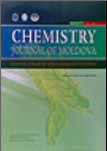Chemistry Journal of Moldova
Research paper
Author(s):
Field: Inorganic and coordination chemistry
Type: Research paper
Issue: 2008 Volume 3, no.2
Pages: 86-94
Sergiu Shova, Ana Lazarescu, Maria Gdaniec, Yurii Simonov, Constantin Turta
Field: Inorganic and coordination chemistry
Type: Research paper
Issue: 2008 Volume 3, no.2
Pages: 86-94
Full Text (PDF): Download
DOI: dx.doi.org/10.19261/cjm.2008.03(2).04
Graphical Abstract: Two novel μ3-oxo-centered carboxylate-bridged triiron complexes [Fe3O(BrCH2COO)6(H2O)3] NO3·2.63H2O (1) and [Fe3O(CH2BrCOO)1.5(CH2ClCOO)4.5(H2O)3]Br0.75Cl0.25 5H2O (2) were synthesized and their structures were characterized by X-ray crystallography. The opportunity of mixed-ligand complex formation in iron(III)-bromoacetic acid system was shown. The first co-ordination sphere of the iron atom in compound 2 includes two different carboxylate anions, CH2BrCOO- and CH2ClCOO- in the capacity of syn-syn- bidentate-bridged ligands, while Br- and Cl- anions being in the ratio 1:1, formulate the external sphere of the complex. The IR spectra, thermic analysis and magnetic properties of complexes were studied.
Downloads: 29
Author(s):
Field: Natural product chemistry and synthesis
Type: Research paper
Issue: 2008 Volume 3, no.2
Pages: 95-97
Viorica Sargarovschi, Eugenia Styngach, Fliur Macaev
Field: Natural product chemistry and synthesis
Type: Research paper
Issue: 2008 Volume 3, no.2
Pages: 95-97
Full Text (PDF): Download
DOI: dx.doi.org/10.19261/cjm.2008.03(2).05
Graphical Abstract: New ionic liquids bearing an imidazolium core with a carboxy group have been prepared in an attempt to design new organocatalysts of Biginelli reaction. Trends in the properties of these compounds are discussed. The synthetized compounds represented a novel class of molted salts and may be considered as new organocatalysts for chemical reaction.
Downloads: 27
Author(s):
Field: Inorganic and coordination chemistry
Type: Research paper
Issue: 2008 Volume 3, no.2
Pages: 81-85
Denis Prodius, Valeriu Mereacre, Maria Gdaniec, Sergiu Shova, Yurii A. Simonov, Nicolae Stanica, Ion Geru, Andrea Caneschi, Constantin Turta
Field: Inorganic and coordination chemistry
Type: Research paper
Issue: 2008 Volume 3, no.2
Pages: 81-85
Full Text (PDF): Download
DOI: dx.doi.org/10.19261/cjm.2008.03(2).06
Graphical Abstract: A novel hexanuclear iron-calcium-oxo complex has been synthesized and characterized by different physico-chemical methods and X-ray single crystal structural analysis: [Fe4Ca2O2(μ2-HCCl2COO)10(μ3-HCCl2COO)2(THF)6].The molecular structure shows that there are two types of coordination for COO- anions: bidentate and tridentate.The corresponding variable temperature susceptibility measurement shows that in the complex there exists an antiferromagnetic interaction (|J12| = |J34| = -71.86 cm-1). The iron(III) high spin state (5/2) is proved by Mössbauer spectroscopy. High magnetic EPR measurements of 1 indicates the presence of S=0 ground state with low-lying S=1 excited state centred around g = 2.0054 ±0.0001.
Downloads: 24
Author(s):
Field: Natural product chemistry and synthesis
Type: Research paper
Issue: 2008 Volume 3, no.2
Pages: 98-100
Natalia Mashcenko, Pavel Kintia, Angela Gurev, Alexandra Marchenko, Carla Bassarello, Sonia Piacente, Cosimo Pizza
Field: Natural product chemistry and synthesis
Type: Research paper
Issue: 2008 Volume 3, no.2
Pages: 98-100
Full Text (PDF): Download
DOI: dx.doi.org/10.19261/cjm.2008.03(2).07
Graphical Abstract: A new flavonol glycoside, 5,4′-dimethylkaempferol 3-O-β-D-(6′′-α-Lrhamnopyranosyl) -glucopyranoside, together with three known compounds were isolated from the n-butanolic soluble fraction of underground and aerial parts of Linaria vulgaris Mill, collected on the territory of Moldova. The characterisation of these compounds was achieved by various chromatographic and spectroscopic methods (IR, UV, 13C-NMR, 1H-NMR and MS).
Downloads: 32
Author(s):
Field: Natural product chemistry and synthesis
Type: Research paper
Issue: 2008 Volume 3, no.2
Pages: 101-104
Alexandra Marchenko, Pavel Kintia, Natalia Mashcenco, Carla Bassarello, Sonia Piacente and Cosimo Pizza
Field: Natural product chemistry and synthesis
Type: Research paper
Issue: 2008 Volume 3, no.2
Pages: 101-104
Full Text (PDF): Download
DOI: dx.doi.org/10.19261/cjm.2008.03(2).08
Graphical Abstract: Three phenylethanoid glycosides (1, 2, 3) and one iridoid glycoside (4) were isolated from aerial parts of Veronica chamaedrys L. (Scrophulariaceae) for the first time. On the basis of spectral analysis, the structures of these compounds were determined to be acteoside (3,4-dihydroxy-β-phenylethoxy-O-α-L-rhamnopyranosyl-(1→3)-4-O-caffeoyl-β-D-glucopyranoside) (1), ehrenoside (3,4-dihydroxy-β-phenylethoxy-O-α-L-arabinopyranosyl-(1→2)-α-L-rhamnopyranosyl-(1→3)-4-O-caffeoyl-β-D-glucopyranoside) (2), chamaedroside (3,4-dihydroxy-β-phenylethoxy-O-α-L-rhamnopyranosyl-(1→3)-4-O-caffeoyl-α-L-arabinopyranoside) (3) and aucuboside (4).
Downloads: 16
Author(s):
Field: Ecological chemistry
Type: Research paper
Issue: 2008 Volume 3, no.2
Pages: 55-57
T. Lupashcu, M. Ciobanu
Field: Ecological chemistry
Type: Research paper
Issue: 2008 Volume 3, no.2
Pages: 55-57
Full Text (PDF): Download
DOI: dx.doi.org/10.19261/cjm.2008.03(2).09
Graphical Abstract: The adsorption process of ammonia ions and ammonium from aqueous solutions on the intact activated carbon obtained from nutshells through activation with phosphoric acid and oxidized with H2O2 and later impregnated with salt containing Co2+, Ag+, Ni2+, Cu2+, has been investigated. The efficiency of ammonia ions and ammonium elimination from various water categories, using both activated carbon (the intact CAN-7 and CAN-7 oxidized with H2O2 and impregnated with Co2+, Ag+, Ni2+, Cu2+ ions) has been demonstrated.
Downloads: 37
Author(s):
Field: Ecological chemistry
Type: Research paper
Issue: 2008 Volume 3, no.2
Pages: 58-64
A.-M.Delort, P.Besse, G.Mailhot, M.Sancelme, B.Combourieu, Ch.Chorao, O.Covaliova, V.Covaliov, A.Bunescu, I.Dragalin, A.Cincilei, S.Tolocichina
Field: Ecological chemistry
Type: Research paper
Issue: 2008 Volume 3, no.2
Pages: 58-64
Full Text (PDF): Download
DOI: dx.doi.org/10.19261/cjm.2008.03(2).14
Graphical Abstract: With the scope to provide complete decomposition of benzothiazoles in water environment, two approaches have been applied including the photocatalytic and biodegradation processes. A new type of continuous-action flow-through photocatalytic reactor was developed, in which it is possible to combine the homogeneous and heterogeneous destruction of refractory organic pollutants. The interactions between the different components of the aminobenzothiazole-containing system under the conditions of photo- and biodegradation (light, iron, free and immobilized bacterial strain Rhodococcus rhodochrous) were analysed. The combined systems “Fe ± light +Rh.rhodochrous” are more effective than simple systems.
Downloads: 14
Author(s):
Field: Inorganic and coordination chemistry
Type: Research paper
Issue: 2008 Volume 3, no.2
Pages: 70-80
Eduard Coropceanu, Alexandra Deseatnic, Maria Stratan, Andrei Rija, Olga Bologa, Janna Tiurin, Svetlana Labliuc, Steliana Clapco, Ion Bulhac
Field: Inorganic and coordination chemistry
Type: Research paper
Issue: 2008 Volume 3, no.2
Pages: 70-80
Full Text (PDF): Download
DOI: dx.doi.org/10.19261/cjm.2008.03(2).15
Graphical Abstract: It was elaborated the methodology of synthesizing a series of new dioximates of Co(III) with the general formula [Co(DioxH)2(L)2]X⋅nH2O, where DioxH – the dioxime anione: dimethylglyoxime (DH2), 1,2-cyclohexanedionedioxime (NioxH2); L - thiocarbamide (Thio), pyridine (Py), aniline (An), sulphanilamide (Sam);X - [BF4]-, [ZrF6]2-, [TiF6]2-, whose structures have been studied with the help of contemporary physical methods: spectroscopy IR, UV-Vis, RMN 1H, 19F, X-ray analysis. There were elaborated optimal conditions of using cobalt dioximates with fluorine in order to intensify the biosynthesis of amylases and lipases by Aspergillus and Rhizopus strains, respectively. The tested compounds increase the lipolytic activity of Rhizopus arrhisus micromycetes.
Downloads: 32
Author(s):
Field: Physical chemistry and chemical physics
Type: Research paper
Issue: 2008 Volume 3, no.2
Pages: 109-113
Ion Arsene
Field: Physical chemistry and chemical physics
Type: Research paper
Issue: 2008 Volume 3, no.2
Pages: 109-113
Full Text (PDF): Download
DOI: dx.doi.org/10.19261/cjm.2008.03(2).18
Graphical Abstract: The geometry of the H2O2, OH, HO2, O2 particles and the energy profiles of the initial reactions between them, that are supposed to take place during the process of decomposition of hydrogen peroxide, were studied by ab initio calculations. It was shown that the differences between the energies of reactants and the products of all analysed reaction are positive values and correlate with the experimental data.
Downloads: 21
Author(s):
Field: Analytical chemistry
Type: Research paper
Issue: 2008 Volume 3, no.1
Pages: 52-55
Gheorghe Zgherea
Field: Analytical chemistry
Type: Research paper
Issue: 2008 Volume 3, no.1
Pages: 52-55
Full Text (PDF): Download
DOI: dx.doi.org/10.19261/cjm.2008.03(1).02
Graphical Abstract: Mixtures of small quantities of carbonyl compounds are presents in foods, concerning sensorial qualities. The inferior carbonyl compounds (C2-C4, boiling point <100°C) – mono and dicarbonyl – can be identified and measured their concentrations, after a separation by distillation on the water bath. They are transferred in a strongly acid solution of 2.4-dinitrophenylhidrazine (2.4-DNPH), generating a mixture of insoluble 2.4-dinitrophenylhidrazones (2.4-DNPH-ones). The 2.4-DNPH-ones are organic compounds with weak polarity, solids, crystallized, yellows and water insoluble, soluble in organic solvents. The mixture of 2.4dinitrophenylhidrazones may be separated by liquid chromatography, using the reverse phase mechanism [1-3]. This paper contains experimental and theoretical considerations to the means of separation through liquid chromatography of two synthetically and a natural mixtures that contain 2.4-DNPH-ones provided by inferior carbonyl compounds; to obtain conclude results, in the synthetically mixtures was introduce and 2.4-DNPH-ones provided by carbonyl compounds having three (acetone and propanal) and four (isobutyl aldehyde) atoms of carbon.
Downloads: 22






